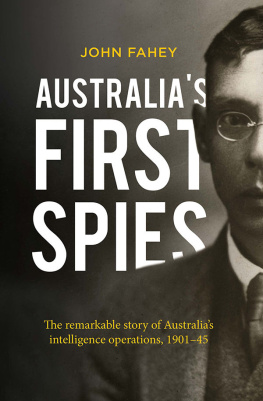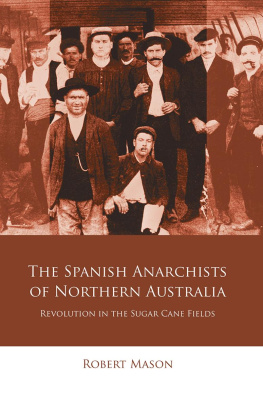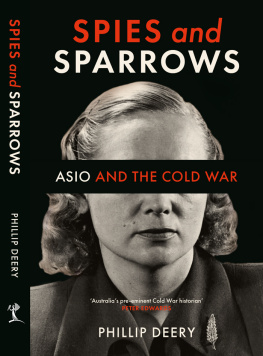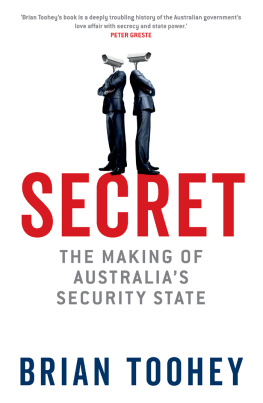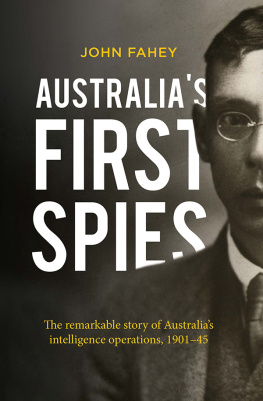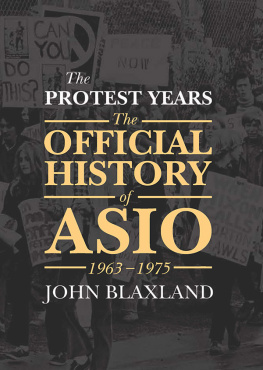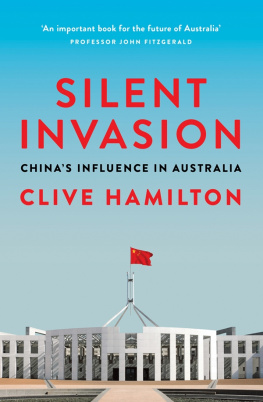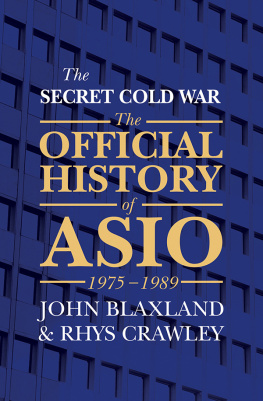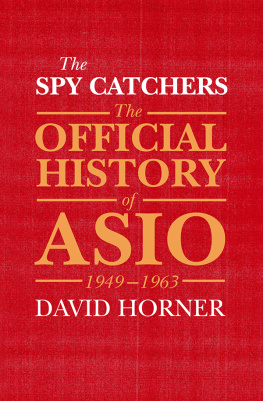
Dr John Fahey worked at Defence Signals Directorate and served in regimental and intelligence postings in the British and Australian armies. He is an Honorary Fellow of the Department of Security Studies and Criminology at Macquarie University and the author of Australias First Spies.
Praise for Australias First Spies
Based on extensive research in Australian, British and American archives vigorous and lucid writing
Peter Edwards, The Australian
lays bare both brilliance and the incompetence in the first 45 years of Australian intelligence
Tim Coyle, The Australian Naval Institute
It is a meticulously researched investigation full of well-grounded assessments, but it is also a well-crafted narrative, all the more appealing because its stories and characters are real.
Peter Monteath, Journal of Pacific History
a fascinating exploration of a largely uncharted domain of Australian history in the formative years of the first half of the twentieth century
John Blaxland, Honest History
an important book dealing with a remarkable story
Rhys Crawley, Australian Historical Studies
To the men and women who keep Antenora full
First published in 2020
Copyright John Fahey 2020
All rights reserved. No part of this book may be reproduced or transmitted in any form or by any means, electronic or mechanical, including photocopying, recording or by any information storage and retrieval system, without prior permission in writing from the publisher. The Australian Copyright Act 1968 (the Act) allows a maximum of one chapter or 10 per cent of this book, whichever is the greater, to be photocopied by any educational institution for its educational purposes provided that the educational institution (or body that administers it) has given a remuneration notice to the Copyright Agency (Australia) under the Act.
Allen & Unwin
83 Alexander Street
Crows Nest NSW 2065
Australia
Phone: (61 2) 8425 0100
Email:
Web: www.allenandunwin.com

ISBN 978 1 76087 770 5
eISBN 978 1 76106 001 4
Index by Garry Cousins
Set by Midland Typesetters, Australia
Cover design: Design by Committee
Cover photograph: Walter Seddon Clayton (ASIO)
The gates of hell are open night and day;
Smooth the descent, and easy is the way:
But to return, and view the cheerful skies,
In this the task and mighty labour lies.
Virgil, The Aeneid, Book 6
T raitors and Spies is about spies and spying in Australia in the first half of the last century, and what the actors involved got right and wrong. It is a warts and all story, as all good history should endeavour to be, because there is no point in delusion. All bad historyhistory that strays from what can be derived from the available evidenceis delusion.
As a work of history, Traitors and Spies is written for the serious reader but it is also a book written for the reader who likes a good yarn, and to these I apologise for the trappings of a hidden world: the frequent notations up the back, the list of abbreviations, the bi-graphs and tri-graphs; and the unfamiliar terms, like HUMINT for human intelligence and CIC for counterintelligence corps. I hope the Abbreviations and Glossary will help with these mysterious technicalities.
In dealing with the acronyms, some are very hard to follow, especially those used for the KGB, or Komitet Gosudarstvennoy Bezopasnosti (Committee for State Security).1 This organisation has been called by a multitude of names over the years, so for sanitys sake we will use NKGB for the civilian agency and GRU for Russian military intelligence throughout Traitors and Spies.
As a history, this book deals with the reality of the time and it therefore draws heavily upon the files and documents held within the national archives of Australia, the United Kingdom and the United States. The value of these files lies in their contemporaneity. They were written by busy bureaucrats who thought their words would ever remain secret, and only read by even busier bureaucrats across a range of agencies. This imposes a level of honesty that is higher than in a memoir or a history, where authors have much more time to reflect upon and choose what they will say, and worry about how their words will be received. I prefer to spend my time among the faceless bureaucrats, because I know that, even though they are faceless, they are committed servants of their governments. They are real people whose story deserves to be told as truthfully as possible.
John Fahey
A s well as being a history of espionage and counterespionage in Australia, his book is also a history of the long and difficult struggle to create an ethical, professional and well-managed counterespionage organisation in Australia. This may sound like a straightforward task for a government, but not for Australian governments, as we will see. The formation of such an organisation was attempted a number of times between Federation in 1901 and the formation of the Australian Security Intelligence Organisation (ASIO) in 1949. Even then, it took another two years for ASIO to rid itself of the corruption and criminality of previous years.
The formation and work of ASIO is one of the most glaring examples in Australian history of myth being portrayed as truth, and this was not a myth perpetuated by mistake. The creation of ASIO was essential if the Australian government was going to fulfil its first duty, to defend the nation and its people from external attack. By 1949 Australia had been under sustained attack from external threats since 1908 and had consistently failed to effectively address them. Rather, it chose to create organisations in which individuals and groups were left unchecked to pursue their own vendettas against those they deemed threatening. The result was the development of an extraordinary level of corruption and, as circumstantial evidence suggests,fraud, deceit, illegal arrests and assaults were carried out by Australian officials against Australian citizens.
Allegations of impropriety, amateurism and partisan partiality often levelled against ASIO are true of the organisations and the people that ASIO replaced. The allegations against ASIO, once it passed its initial teething period, are no more than poorly researched partisan mythology. The problem caused by this preponderance of partisan myth is that it detracts from the true story of the real oppression and callous disregard of the law that did occur. The targets of these terrible actions were not only communists or foreigners, but Australian citizens who held what were, at the time, unpopular religious or political views.
Today, we have numerous books and articles exposing the historic injustices perpetrated against communists, socialists, trade unionists and even the Australian Labor Party (ALP). Between 1916 and 1949, there is some truth to these allegations, but many of the books and articles written fail to identify other individual Australians and groups that were systematically hounded by Australias security services and even illegally deprived of their freedom and property by Australian governments. These individuals and groups were not communists, socialists, unionists or Labor members, but the devout and the odd. It was not the experienced, well-organised and highly competent communists who were most at risk; it was the easily identified and vulnerable who were the prey of the pre-1949 security services. That this was the case is unsurprising.
Next page

